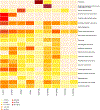The SWI/SNF complex in cancer - biology, biomarkers and therapy
- PMID: 32303701
- PMCID: PMC8723792
- DOI: 10.1038/s41571-020-0357-3
The SWI/SNF complex in cancer - biology, biomarkers and therapy
Abstract
Cancer genome-sequencing studies have revealed a remarkably high prevalence of mutations in genes encoding subunits of the SWI/SNF chromatin-remodelling complexes, with nearly 25% of all cancers harbouring aberrations in one or more of these genes. A role for such aberrations in tumorigenesis is evidenced by cancer predisposition in both carriers of germline loss-of-function mutations and genetically engineered mouse models with inactivation of any of several SWI/SNF subunits. Whereas many of the most frequently mutated oncogenes and tumour-suppressor genes have been studied for several decades, the cancer-promoting role of mutations in SWI/SNF genes has been recognized only more recently, and thus comparatively less is known about these alterations. Consequently, increasing research interest is being focused on understanding the prognostic and, in particular, the potential therapeutic implications of mutations in genes encoding SWI/SNF subunits. Herein, we review the burgeoning data on the mechanisms by which mutations affecting SWI/SNF complexes promote cancer and describe promising emerging opportunities for targeted therapy, including immunotherapy with immune-checkpoint inhibitors, presented by these mutations. We also highlight ongoing clinical trials open specifically to patients with cancers harbouring mutations in certain SWI/SNF genes.
Conflict of interest statement
Competing interests
The authors declare no competing interests.
Figures



References
Publication types
MeSH terms
Substances
Grants and funding
LinkOut - more resources
Full Text Sources
Other Literature Sources
Medical

